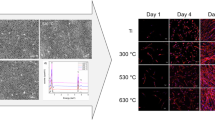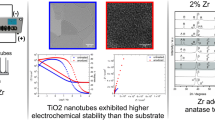Abstract
TiO2 nanotubes array gives entirely new types of interactions between titanium surfaces and cells due to the surface area increase and topography that resemble native bone tissue, and has been extensively studied as a promising technique to surface modification of implants. It is also well established that the annealing of anodized titanium surfaces significantly affects the properties of TiO2 nanotubes, as well as the interaction with cells. Usually, titanium implants are subjected to micromovements under loading conditions in an aggressive biological environment, which causes tribocorrosion. The resulting debris from a tribocorrosive process could lead to infectious problems and eventually implant loss. This work aimed to evaluate the influence of the annealing treatment on the microstructure and mechanical properties of a TiO2 nanotube layer produced on titanium, and consequently, on the tribocorrosive resistance, and the biological response to human dermal fibroblasts (HDF). Commercially pure titanium (grade 4) samples were anodized through the potentiostatic method using an aqueous electrolyte containing Ca and P and, after anodizing, submitted to annealing at different temperatures. The modified surfaces were characterized by scanning electron microscopy (SEM), energy-dispersive spectrometry (EDS), X-ray diffraction (DRX), tribocorrosion tests, and bioactivity using HDF. Our results show that the annealing affects significantly the mechanical and tribological properties of the nanotubes layer. We also observed an increase in phosphorous amount with annealing temperature, which, along with the increase in the rutile crystalline phase amount, increases cells’ adhesion and proliferation.











Similar content being viewed by others

References
Chen Q, Thouas GA (2015) Metallic implant biomaterials. Mat Sci Eng R 87:1–57. https://doi.org/10.1016/j.mser.2014.10.001
Rack HJ, Qazi JI (2006) Titanium alloys for biomedical applications. Mat Sci Eng C 26:1269–1277. https://doi.org/10.1016/j.msec.2005.08.032
Sul YT, Johansson CB, Jeong Y, Albrektsson T (2001) The electrochemical oxide growth behaviour on titanium in acid and alkaline electrolytes. Med Eng Phys 23:329–346. https://doi.org/10.1016/S1350-4533(01)00050-9
Lautenschlager EP, Monaghan P (1993) Titanium and titanium alloys as dental materials. Int Dent J 43(3):245–253
Smeets R, Stadlinger B, Schwarz F, Beck-Broichsitter B, Jung O, Precht C, Kloss F, Gröbe A, Heiland M, Ebker T (2016) Impact of dental implant surface modifications on osseointegration. Biomed Res Int 2016:6285620. https://doi.org/10.1155/2016/6285620
Cai K, Frant M, Bossert J, Hildebrand G, Liefeith K, Jandt KD (2006) Surface functionalized titanium thin films: zeta-potential, protein adsorption and cell proliferation. Colloids Surf B Biointerfaces 50(1):1–8. https://doi.org/10.1016/j.colsurfb.2006.03.016
Puleo DA, Nanci A (1999) Understanding and controlling the bone-implant interface. Biomaterials 20(23–24):2311–2321. https://doi.org/10.1016/S0142-9612(99)00160-X
Rupp F, Liang L, Geis-Gerstorfer J, Scheideler L, Hüttig F (2018) Surface characteristics of dental implants: a review. Dent Mater 34(1):40–57. https://doi.org/10.1016/j.dental.2017.09.007
Popat KC, Leoni L, Grimes CA, Desai TA (2007) Influence of engineered titania nanotubular surfaces on bone cells. Biomaterials 28:3188–3197. https://doi.org/10.1016/j.biomaterials.2007.03.020
Oh S, Jin S, Titanium oxide nanotubes with controlled morphology for enhanced bone growth (2006) Mat Sci Eng C 26(8): 1301–06. Doi: 10.1016/j.msec.2005.08.014.
Bjursten LM, Rasmusson L, Oh S, Smith GC, Brammer KS, Jin S (2010) Titanium dioxide nanotubes enhance bone bonding in vivo. J Biomed Mater Res A 92(3):1218–1224. https://doi.org/10.1002/jbm.a.32463
Brammer KS, Oh S, Cobb CJ, Bjursten LM, van der Heyde H, Jin S (2009) Improved bone-forming functionality on diameter-controlled TiO2 nanotube surface. Acta Biomater 5(8):3215–3223. https://doi.org/10.1016/j.actbio.2009.05.008
Brett PM, Harle J, Salih V, Mihoc R, Olsen I, Jones FH, Tonetti M (2004) Roughness response genes in osteoblasts. Bone 35(1):124–133. https://doi.org/10.1016/j.bone.2004.03.009
Kulkarni M, Mazare A, Gongadze E, Perutkova S, Kralj-Iglic V, Milošev I, Schmuki P, Iglič A, Mozetič M (2015) Titanium nanostructures for biomedical applications. Nanotechnology 26(6):062002. https://doi.org/10.1088/0957-4484/26/6/062002
Souza JCM, Sordi MB, Kanazawa M, Ravindran S, Henriques B, Silva FS, Aparicio C, Cooper LF (2019) Nano-scale modification of titanium implant surfaces to enhance osseointegration. Acta Biomater 94:112–131. https://doi.org/10.1016/j.actbio.2019.05.045
Davey AV (2017) The effect of manufacturing techniques on custom-made titanium cranioplasty plates: a pilot study. J Craniomaxillofac Surg 45(12):2017–2027. https://doi.org/10.1016/j.jcms.2017.09.020
Bressan E, Sbricoli L, Guazzo R, Tocco I, Roman M, Vindigni V, Stellini E, Gardin C, Ferroni L, Sivolella S, Zavan B (2013) Nanostructured surfaces of dental implants. Int J Mol Sci 14(1):1918–1931. https://doi.org/10.3390/ijms14011918
Salou L, Hoornaert A, Louarn G, Layrolle P (2015) Enhanced osseointegration of titanium implants with nanostructured surfaces: an experimental study in rabbits. Acta Biomater 11:494–502. https://doi.org/10.1016/j.actbio.2014.10.017
Moore B, Asadi E, Lewis G (2017) Deposition methods for microstructured and nanostructured coatings on metallic bone implants: a review. Adv Mater Sci Eng. https://doi.org/10.1155/2017/5812907
Yeo IL (2019) Modifications of dental implant surfaces at the micro- and nano-level for enhanced osseointegration. Materials 13(1):89. https://doi.org/10.3390/ma13010089
Kasuga T, Hiramatsu M, Hoson A, Sekino T, Niihara K (1998) Formation of titanium oxide nanotube. Langmuir 14(12):3160–3163. https://doi.org/10.1021/la9713816
Tsai CC, Nian JN, Teng H (2006) Mesoporous nanotube aggregates obtained from hydrothermally treating TiO2 with NaOH. Appl Surf Sci 253(4):1898–1902. https://doi.org/10.1016/j.apsusc.2006.03.035
Lee JH, Leu IC, Hsu MC, Chung YW, Hon MH (2005) Fabrication of aligned TiO2 one-dimensional nanostructured arrays using a one-step templating solution approach. J Phys Chem B 109(27):13056–13059. https://doi.org/10.1021/jp052203l
Gong D, Grimes CA, Varghese OK, Hu W, Singh RS, Chen Z, Dickey EC (2001) Titanium oxide nanotube arrays prepared by anodic oxidation. J Mater Res 16(12):3331–3334. https://doi.org/10.1557/jmr.2001.0457
Fu Y, Mo A (2018) A review on the electrochemically self-organized titania nanotube arrays: synthesis, modifications, and biomedical applications. Nanoscale Res Lett 13(1):187. https://doi.org/10.1186/s11671-018-2597-z
Roy P, Berger S, Schmuki P (2011) TiO2 Nanotubes: synthesis and applications. Angew Chem Int Ed 50:2904–2939. https://doi.org/10.1002/anie.201001374
Soares P, Dias-Netipanyj MF, Elifio-Esposito S, Leszczak V, Popat K (2018) Effects of calcium and phosphorus incorporation on the properties and bioactivity of TiO2 nanotubes. J Biomater Appl 33:410–421. https://doi.org/10.1177/0885328218797549
Alves AC, Oliveira F, Wenger F, Ponthiaux P, Celis J-P, Rocha LA (2013) Tribocorrosion behaviour of anodic treated titanium surfaces intended for dental implants. J Phys D Appl Phys 46(40):404001. https://doi.org/10.1088/0022-3727/46/40/404001
Mathew MT, Pai PS, Pourzal R, Fischer A, Wimmer MA (2009) Significance of tribocorrosion in biomedical applications: overview and current status. Adv Tribol. https://doi.org/10.1155/2009/250986
Das K, Bandyopadhyay A, Bose S (2008) Biocompatibility and in situ growth of TiO2 nanotubes on Ti using different electrolyte chemistry. J Am Ceram Soc 91(9):2808–2814. https://doi.org/10.1111/j.1551-2916.2008.02545.x
Li MO, Xiao X, Liu R (2008) Synthesis and bioactivity of highly ordered TiO2 nanotube arrays. Appl Surf Sci 255(2):365–367. https://doi.org/10.1016/j.apsusc.2008.06.108
Dias-Netipanyj MF, Cowden K, Sopchenski L, Cogo SC, Elifio-Esposito S, Popat KC, Soares P (2019) Effect of crystalline phases of titania nanotube arrays on adipose derived stem cell adhesion and proliferation. Mat Sci Eng C Mater Biol Appl 103:109850. https://doi.org/10.1016/j.msec.2019.109850
Jin F, Chu PK, Wang K, Zhao J, Huang A, Tong H (2008) Thermal stability of titania films prepared on titanium by micro-arc oxidation. Mat Sci Eng A Struct 476(1–2):78–82. https://doi.org/10.1016/j.msea.2007.05.070
Krishna DSR, Brama YL, Sun Y (2007) Thick rutile layer on titanium for tribological applications. Tribol Int 40(2):329–334. https://doi.org/10.1016/j.triboint.2005.08.004
Yetim AF (2010) Investigation of wear behavior of titanium oxide films, produced by anodic oxidation, on commercially pure titanium in vacuum conditions. Surf Coat Tech 205(6):1757–1763. https://doi.org/10.1016/j.surfcoat.2010.08.079
Alves SA, Rossi AL, Ribeiro AR, Toptan F, Pinto AM, Shokuhfar T, Celis JP, Rocha LA (2018) Improved tribocorrosion performance of bio-functionalized TiO2 nanotubes under two-cycle sliding actions in artificial saliva. J Mech Behav Biomed Mater 80:143–154. https://doi.org/10.1016/j.jmbbm.2018.01.038
Ratner B, Brunette DM, Tengvall P, Textor M, Thomsen P (2001) A perspective on titanium biocompatibility. Engineering Materials. Springer, Berlin
Villar CC, Huynh-Ba G, Mills MP, Cochran DL (2011) Wound healing around dental implants. Endodon Top 25(1):44–62. https://doi.org/10.1111/etp.12018
Oliver WC, Pharr GM (2004) Measurement of hardness and elastic modulus by instrumented indentation: advances in understanding and refinements to methodology. J Mater Res 19:3–20. https://doi.org/10.1557/jmr.2004.19.1.3
Spurr RA, Myers H (1957) Quantitative analysis of anatase–rutile mixtures with an X-ray diffractometer. Anal Chem 29(5):760–762
Wang G, Li J, Lv K et al (2016) Surface thermal oxidation on titanium implants to enhance osteogenic activity and in vivo osseointegration. Sci Rep 6:31769. https://doi.org/10.1038/srep31769
Xu YN, Liu MN, Wang MC, Oloyede A, Bell JM, Yan C (2015) Nanoindentation study of the mechanical behavior of TiO2 nanotube arrays. J Appl Phys 118:145301. https://doi.org/10.1063/1.4932213
Crawford GA, Chawla N, Houston JE (2009) Nanomechanics of biocompatible TiO2 nanotubes by Interfacial Force Microscopy (IFM). J Mech Behav Biomed Mater 2(6):580–587. https://doi.org/10.1016/j.jmbbm.2008.10.004
Crawford GA, Chawla N, Das K, Bose S, Bandyopadhyay A (2007) Microstructure and deformation behavior of biocompatible TiO2 nanotubes on titanium substrate. Acta Biomater 3(3):359–367. https://doi.org/10.1016/j.actbio.2006.08.004
Chang WY, Fang TH, Chiu ZW, Hsiao YJ, Ji LW (2011) Nanomechanical properties of array TiO2 nanotubes. Microp Mesop Mater 145(1–3):87–92. https://doi.org/10.1016/j.micromeso.2011.04.035
Zalnezhad E, Baradaran S, Bushroa AR, Sarhan AAD (2014) Mechanical property enhancement of Ti-6Al-4V by Multilayer thin solid film Ti/TiO2 nanotubular array coating for biomedical application. Metall Mater Trans A 45A(2):785–797. https://doi.org/10.1007/s11661-013-2043-x
Schmidt-Stein F, Thiemann S, Berger S, Hahn R, Schmuki P (2010) Mechanical properties of anatase and semi-metallic TiO2 nanotubes. Acta Mater 58(19):6317–6323. https://doi.org/10.1016/j.actamat.2010.07.053
Laurindo CAH, Lepienski CM, Amorim FL, Torres RD, Soares P (2018) Mechanical and tribological properties of Ca/P-doped titanium dioxide layer produced by plasma electrolytic oxidation: effects of applied voltage and heat treatment. Tribol Trans 61(4):733–741. https://doi.org/10.1080/10402004.2017.1404176
Li T, Gulati K, Wang N, Zhang Z, Ivanovski S (2018) Understanding and augmenting the stability of therapeutic nanotubes on anodized titanium implants. Mater Sci Eng C Mater Biol Appl 88:182–195. https://doi.org/10.1016/j.msec.2018.03.007
Acevedo-Peña P, Carrera-Crespo JE, González F, González I (2014) Effect of heat treatment on the crystal phase composition, semiconducting properties and photoelectrocatalytic color removal efficiency of TiO2 nanotubes arrays. Electrochim Acta 140:564–571. https://doi.org/10.1016/j.electacta.2014.06.056
Quinn SJ, Thomsen AR, Pang JL, Kantham L, Bräuner-Osborne H, Pollak M, Goltzman D, Brown EM (2013) Interactions between calcium and phosphorus in the regulation of the production of fibroblast growth factor 23 in vivo. Am J Physiol Endocrinol Metab 304(3):E310–E320. https://doi.org/10.1152/ajpendo.00460.2012
Uchida M, Kim HM, Kokubo T, Fujibayashi S, Nakamura T (2003) Structural dependence of apatite formation on titania gels in a simulated body fluid. J Biomed Mater Res A 64(1):164–170. https://doi.org/10.1002/jbm.a.10414
An SH, Narayanan R, Matsumoto T, Lee HJ, Kwon TY, Kim KH (2011) Crystallinity of anodic TiO2 nanotubes and bioactivity. J Nanosci Nanotechnol 11(6):4910–4918. https://doi.org/10.1166/jnn.2011.4114
Acknowledgements
The authors would like to acknowledge the National Council for Scientific and Technological Development (CNPq), Grant No. 420588/2013-2—PVE, Coordination for the Improvement of Higher Education Personnel (CAPES), and Fundação Araucária/CAPES 17/2014, Grant 23038.007035/2014-51 for funding this work.
Author information
Authors and Affiliations
Corresponding author
Ethics declarations
Conflict of interest
On behalf of all authors, the corresponding author states that there is no conflict of interest.
Additional information
Publisher's Note
Springer Nature remains neutral with regard to jurisdictional claims in published maps and institutional affiliations.
Rights and permissions
About this article
Cite this article
Fontes, A.C.C.A., Sopchenski, L., Laurindo, C.A.H. et al. Annealing Temperature Effect on Tribocorrosion and Biocompatibility Properties of TiO2 Nanotubes. J Bio Tribo Corros 6, 64 (2020). https://doi.org/10.1007/s40735-020-00363-w
Received:
Revised:
Accepted:
Published:
DOI: https://doi.org/10.1007/s40735-020-00363-w



